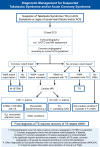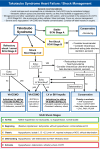Takotsubo syndrome: between evidence, myths, and misunderstandings
- PMID: 32206851
- PMCID: PMC7198647
- DOI: 10.1007/s00059-020-04906-2
Takotsubo syndrome: between evidence, myths, and misunderstandings
Abstract
Takotsubo syndrome (TS) is an acute cardiac condition characterized by transient wall motion abnormalities mostly of the left ventricle. First described in 1990, TS has gained substantial attention during the past 15 years. However, the disease is still underdiagnosed. Prospective studies on TS are largely lacking, and the condition remains incompletely understood. In addition, significant misconceptions and misunderstandings are evident, contributing to potentially severe underestimation. Here, we review important aspects of TS with a focus on pitfalls, misinterpretations, and knowledge gaps considered important during diagnosis and management of the disease.
Das Takotsubo-Syndrom ist eine akute Erkrankung, die durch transiente Wandbewegungsstörungen überwiegend der linken Herzkammer gekennzeichnet ist. Nachdem sie 1990 erstmals beschrieben wurde, hat sie insbesondere in den letzten 15 Jahren enorme Aufmerksamkeit erfahren. Dennoch ist die Erkrankung unterdiagnostiziert. Es gibt kaum prospektive Studien, und das Takotsubo-Syndrom ist in vielen Aspekten noch nicht ausreichend verstanden. Darüber hinaus existieren zahlreiche Missverständnisse, die potenziell dazu beitragen, die Erkrankung zu unterschätzen. Hier geben die Autoren einen Überblick über wichtige Aspekte des Takotsubo-Syndroms unter besonderer Berücksichtigung möglicher Fehlinterpretationen und Wissenslücken, die für Diagnose und Behandlung von Bedeutung sind.
Keywords: Acute heart failure; Cardiogenic shock; Mechanical circulatory support; Pulmonary artery catheterization; Stress cardiomyopathy.
Conflict of interest statement
L.C. Napp: Related to the present work: None. Unrelated to the present work: Modest honoraria for consultancy, proctoring, lectures and travel support from Abiomed, modest honoraria for consultancy, lectures and travel support and research funding from Cytosorbents, modest honoraria for consultancy and travel support from Bayer, modest lecture honoraria from Abbott, Maquet, Orion and Zoll, and travel support from Biotronik, Boston Scientific, Lilly, Medtronic, Merit Medical, Pfizer, Servier, and Volcano. J. Bauersachs: Related to the present work: None. Unrelated to the present work: Honoraria for lectures and/or consulting: Novartis, BMS, Pfizer, Vifor, Bayer, Servier, Orion, CVRx, MSD, Boehringer Ingelheim, AstraZeneca, Abiomed, Abbott, Medtronic; Research support: Zoll, CVRx, Bayer, Vifor, Abiomed, Medtronic.
Figures




Similar articles
-
Impella Mechanical Circulatory Support for Takotsubo Syndrome With Shock: A Retrospective Multicenter Analysis.Cardiovasc Revasc Med. 2022 Jul;40:113-119. doi: 10.1016/j.carrev.2021.11.018. Epub 2021 Nov 19. Cardiovasc Revasc Med. 2022. PMID: 34916157
-
Clinical management in the takotsubo syndrome.Expert Rev Cardiovasc Ther. 2019 Feb;17(2):83-93. doi: 10.1080/14779072.2019.1556098. Epub 2018 Dec 14. Expert Rev Cardiovasc Ther. 2019. PMID: 30513007 Review.
-
Mechanical circulatory support for Takotsubo syndrome: a systematic review and meta-analysis.Int J Cardiol. 2020 Oct 1;316:31-39. doi: 10.1016/j.ijcard.2020.05.033. Epub 2020 May 28. Int J Cardiol. 2020. PMID: 32473281
-
Stress-Induced Cardiomyopathy.Heart Fail Clin. 2019 Jan;15(1):41-53. doi: 10.1016/j.hfc.2018.08.005. Heart Fail Clin. 2019. PMID: 30449379 Review.
-
Takotsubo Cardiomyopathy Following Cardiac Surgery.J Card Surg. 2016 Feb;31(2):89-95. doi: 10.1111/jocs.12675. Epub 2015 Dec 9. J Card Surg. 2016. PMID: 26661572 Review.
Cited by
-
Takotsubo Syndrome: Special Attention to Women's Health.Braz J Cardiovasc Surg. 2022 Oct 8;37(5):792. doi: 10.21470/1678-9741-2022-0312. Braz J Cardiovasc Surg. 2022. PMID: 36346775 Free PMC article. No abstract available.
-
Heart Break or Headache: A Case Report of Sumatriptan-Induced Takotsubo Syndrome.Cureus. 2023 Sep 26;15(9):e45990. doi: 10.7759/cureus.45990. eCollection 2023 Sep. Cureus. 2023. PMID: 37900384 Free PMC article.
-
Takotsubo syndrome as an overlooked and elusive cause of a single episode of dyspnea in young women: a case report.BMC Cardiovasc Disord. 2021 Sep 10;21(1):430. doi: 10.1186/s12872-021-02239-4. BMC Cardiovasc Disord. 2021. PMID: 34507531 Free PMC article.
-
Opportunities and Limitations in the Study of Transient Takotsubo Syndrome in Animal Models.J Clin Med Res. 2020 Jun;12(6):325-328. doi: 10.14740/jocmr4225. Epub 2020 Jun 4. J Clin Med Res. 2020. PMID: 32587648 Free PMC article. No abstract available.
-
Pathophysiology of Takotsubo Cardiomyopathy: Reopened Debate.Tex Heart Inst J. 2021 Jul 1;48(3):e207490. doi: 10.14503/THIJ-20-7490. Tex Heart Inst J. 2021. PMID: 34388240 Free PMC article. Review.
References
-
- Sato H, Tateishi H, Uchida T, et al. Takotsubo-type cardiomyopathy due to multivessel spasm. In: Kodama K, Haze K, Hori M, et al., editors. Clinical aspect of myocardial injury: from Ischemia to heart failure. Tokyo: Kagakuhyouronsha Publishing; 1990. pp. 56–64.
-
- Dote K, Sato H, Tateishi H, et al. Myocardial stunning due to simultaneous multivessel coronary spasms: a review of 5 cases. J Cardiol. 1991;21(2):203–214. - PubMed
Publication types
MeSH terms
LinkOut - more resources
Full Text Sources
Miscellaneous

